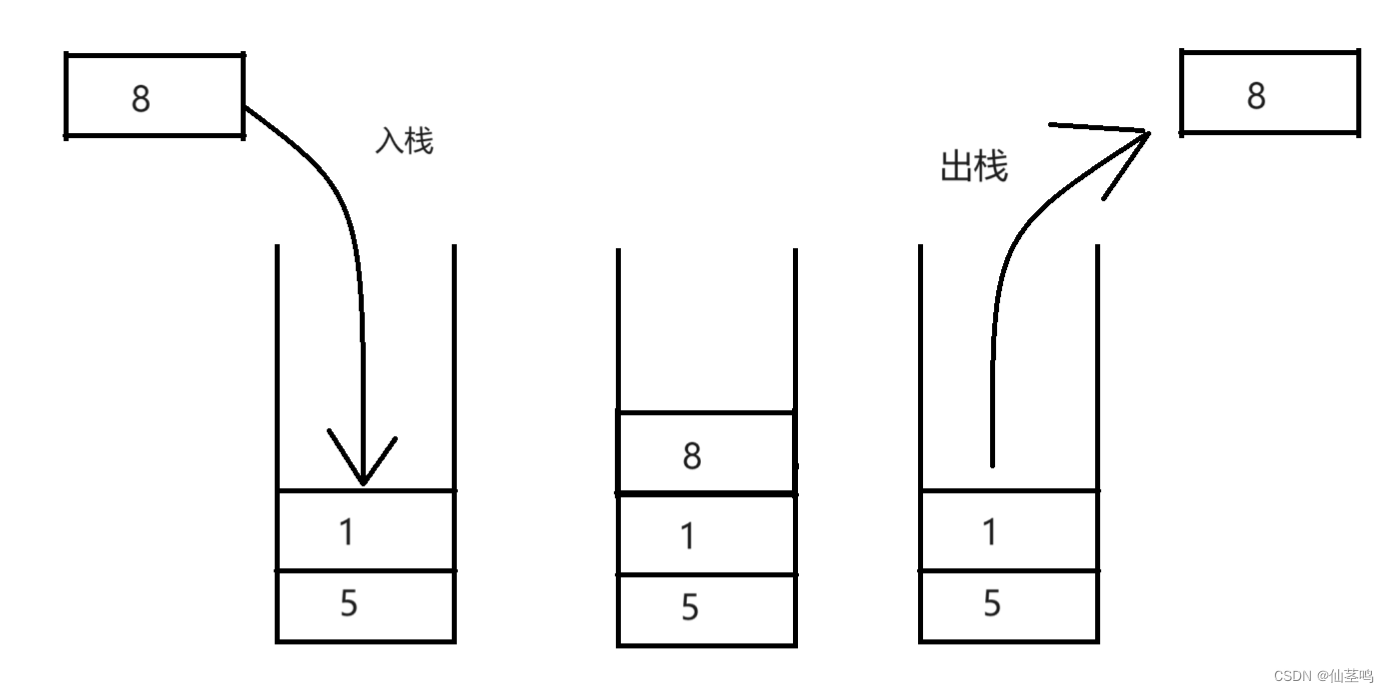目录
栈
概念:
栈是一种特殊的线性表,其结构的特性和内存中的栈是一样的,只允许在固定的一端进行插入和删除元素操作。进行数据插入和删除操作的一端称为栈顶,另一端称为栈底。栈中的数据元素遵守后进先出LIFO(Last In First Out)的原则。
压栈:栈的插入操作叫做进栈/压栈/入栈,入数据在栈顶。
出栈:栈的删除操作叫做出栈。出数据也在栈顶。

5先放入,再依次当如1和8,出栈时只能从8开始出栈,后进入的先出。8 1 5
数组实现:
栈是可以使用链表或数组实现,根据栈的性质:后入先出,那就是尾插和尾删,数组的时间复杂度是O(1),链表的时间复杂度是O(N),数组是更有性价比的。
结构:
typedef char STDataType;
typedef struct Stack
{
STDataType* _a;
int _top; // 栈顶
int _capacity; // 容量
}Stack;_top:记录当前栈的元素个数
_capacity:记录开辟了多大的空间
_a:存储数据
初始化:
void StackInit(Stack* ps)
{
assert(ps);
ps->_a = NULL;
ps->_capacity = 0;
ps->_top = 0;
}入栈:
void StackPush(Stack* ps, STDataType data)
{
assert(ps);
if (ps->_top==ps->_capacity)
{
int newcap = ps->_capacity == 0 ? 4 : ps->_capacity * 2;
STDataType* new_a = (STDataType*)realloc(ps->_a, sizeof(STDataType) * newcap);
if (new_a == NULL)
{
perror("realloc fail");
return;
}
ps->_a = new_a;
ps->_capacity = newcap;
}
ps->_a[ps->_top] = data;
ps->_top++;
}开辟内存和顺序表的思路一样,_capacity为0开辟4个字节,不为0开辟原内存大小的二倍。_top是元素的个数,也是栈顶元素下一个元素的下标,所以直接在下标_top位置插入。
出栈:
void StackPop(Stack* ps)
{
assert(ps);
assert(ps->_top > 0);
ps->_top--;
}出栈时不需要修改值,在次入栈到出过栈的那块空间时,会重新放入元素。
获取栈顶元素:
STDataType StackTop(Stack* ps)
{
assert(ps);
assert(ps->_top > 0);
return ps->_a[ps->_top-1];
}前面说过_top是栈顶元素下一个元素的下标,_top-1也就是栈顶元素的下标。返回前要判断栈是否为空。
获取栈有效的元素个数:
int StackSize(Stack* ps)
{
assert(ps);
return ps->_top;
}栈是否为空,为空返回真:
int StackEmpty(Stack* ps)
{
assert(ps);
return ps->_top == 0;
}销毁:
void StackDestroy(Stack* ps)
{
assert(ps);
free(ps->_a);
ps->_a = NULL;
ps->_capacity = ps->_top = 0;
}全部代码:
stack.h:
#pragma once
#include<stdlib.h>
#include<assert.h>
#include<stdbool.h>
// 支持动态增长的栈
typedef char STDataType;
typedef struct Stack
{
STDataType* _a;
int _top; // 栈顶
int _capacity; // 容量
}Stack;
// 初始化栈
void StackInit(Stack* ps);
// 入栈
void StackPush(Stack* ps, STDataType data);
// 出栈
void StackPop(Stack* ps);
// 获取栈顶元素
STDataType StackTop(Stack* ps);
// 获取栈中有效元素个数
int StackSize(Stack* ps);
// 检测栈是否为空,如果为空返回非零结果,如果不为空返回0
int StackEmpty(Stack* ps);
// 销毁栈
void StackDestroy(Stack* ps);stack.c:
#define _CRT_SECURE_NO_WARNINGS 1
#include<stdio.h>
#include"stack.h"
void StackInit(Stack* ps)
{
assert(ps);
ps->_a = NULL;
ps->_capacity = 0;
ps->_top = 0;
}
void StackPush(Stack* ps, STDataType data)
{
assert(ps);
if (ps->_top==ps->_capacity)
{
int newcap = ps->_capacity == 0 ? 4 : ps->_capacity * 2;
STDataType* new_a = (STDataType*)realloc(ps->_a, sizeof(STDataType) * newcap);
if (new_a == NULL)
{
perror("realloc fail");
return;
}
ps->_a = new_a;
ps->_capacity = newcap;
}
ps->_a[ps->_top] = data;
ps->_top++;
}
void StackPop(Stack* ps)
{
assert(ps);
assert(ps->_top > 0);
ps->_top--;
}
STDataType StackTop(Stack* ps)
{
assert(ps);
assert(ps->_top > 0);
return ps->_a[ps->_top-1];
}
int StackSize(Stack* ps)
{
assert(ps);
return ps->_top;
}
int StackEmpty(Stack* ps)
{
assert(ps);
return ps->_top == 0;
}
void StackDestroy(Stack* ps)
{
assert(ps);
free(ps->_a);
ps->_a = NULL;
ps->_capacity = ps->_top = 0;
}测试:
void test()
{
Stack pc;
StackInit(&pc);
StackPush(&pc, 1);
StackPush(&pc, 2);
printf("%d ", StackTop(&pc));
StackPop(&pc);
StackPush(&pc, 3);
StackPush(&pc, 4);
printf("%d ", StackTop(&pc));
StackPop(&pc);
StackPush(&pc, 5);
while (!StackEmpty(&pc))
{
printf("%d ", StackTop(&pc));
StackPop(&pc);
}
StackDestroy(&pc);
}在入栈是时,可以在中途出栈,这样原本顺序为5 4 3 2 1,改为2 4 5 3 1。在遍历时以栈是否为空来作为循环的结束条件。
队列:
概念:
队列也是一种线性表,它和栈的性质相反,队列为先进先出。只允许在一端进行插入数据操作,在另一端进行删除数据操作。
入队列:进行插入操作的一端称为队尾
出队列:进行删除操作的一端称为队头

链表实现:
队列也可以使用数组和链表进行实现,不过数组无论头部作为出还是入都是不方便的。使用链表让头节点当队头,尾节点当队尾,创建时用一个指针来指向队尾就方便入队了。不需要尾删链表还是很方便的。
结构:
// 链式结构:表示队列
typedef int QDataType;
typedef struct QListNode
{
struct QListNode* _next;
QDataType _data;
}QNode;
// 队列的结构
typedef struct Queue
{
QNode* _front;
QNode* _rear;
int size;
}Queue;_front:指向头节点
_rear:指向尾节点
size:存储有效的元素个数
初始化:
void QueueInit(Queue* q)
{
assert(q);
q->_front = q->_rear = NULL;
q->size = 0;
}队尾入列:
void QueuePush(Queue* q, QDataType data)
{
assert(q);
QNode* top = (QNode*)malloc(sizeof(QNode));
if (top == NULL)
{
perror("malloc fail");
return;
}
top->_data = data;
top->_next = NULL;
q->size++;
if (q->_front == NULL)
{
q->_front = q->_rear = top;
return;
}
q->_rear->_next = top;
q->_rear = top;
}创建一个节点top,top的next要指向NULL,它插入后要作为尾节点。使_rear的next指向top,top这时就为尾节点,_rear再指向top,保证_rear永远为尾节点。插入top前要判断队列是否为空,为空_front和_rear直接指向top。
队头出列:
void QueuePop(Queue* q)
{
assert(q);
assert(q->_front);
QNode* top = q->_front->_next;
free(q->_front);
q->_front = top;
q->size--;
if (q->_front == NULL)
q->_rear = NULL;
}队列不为空再进行出列删除,存储_front的下一个节点,它将作为头节点,然后释放掉_front,_front再指向存储的节点,如果此时_front为空,那队列此时就是空队列,_rear也要指向空。
获取队头元素:
QDataType QueueFront(Queue* q)
{
assert(q && q->_front);
return q->_front->_data;
}获取队尾元素:
QDataType QueueBack(Queue* q)
{
assert(q && q->_rear);
return q->_rear->_data;
}获取队列中的有效元素个数:
int QueueSize(Queue* q)
{
assert(q);
return q->size;
}队列是否为空,为空返回真:
int QueueEmpty(Queue* q)
{
assert(q);
return q->_front == NULL;
}销毁:
void QueueDestroy(Queue* q)
{
assert(q);
QNode* cur = q->_front;
while (cur)
{
q->_front = q->_front->_next;
free(cur);
cur = q->_front;
}
q->_rear = q->_front = NULL;
q->size = 0;
}和链表一样遍历一遍释放所有节点,队列内的变量在置为0。
全部代码:
QNode.h
#pragma once
#include<assert.h>
#include<stdlib.h>
// 链式结构:表示队列
typedef int QDataType;
typedef struct QListNode
{
struct QListNode* _next;
QDataType _data;
}QNode;
// 队列的结构
typedef struct Queue
{
QNode* _front;
QNode* _rear;
int size;
}Queue;
// 初始化队列
void QueueInit(Queue* q);
// 队尾入队列
void QueuePush(Queue* q, QDataType data);
// 队头出队列
void QueuePop(Queue* q);
// 获取队列头部元素
QDataType QueueFront(Queue* q);
// 获取队列队尾元素
QDataType QueueBack(Queue* q);
// 获取队列中有效元素个数
int QueueSize(Queue* q);
// 检测队列是否为空,如果为空返回非零结果,如果非空返回0
int QueueEmpty(Queue* q);
// 销毁队列
void QueueDestroy(Queue* q);QNode.c
#define _CRT_SECURE_NO_WARNINGS 1
#include<stdio.h>
#include"Queue.h"
void QueueInit(Queue* q)
{
assert(q);
q->_front = q->_rear = NULL;
q->size = 0;
}
void QueuePush(Queue* q, QDataType data)
{
assert(q);
QNode* top = (QNode*)malloc(sizeof(QNode));
if (top == NULL)
{
perror("malloc fail");
return;
}
top->_data = data;
top->_next = NULL;
q->size++;
if (q->_front == NULL)
{
q->_front = q->_rear = top;
return;
}
q->_rear->_next = top;
q->_rear = top;
}
void QueuePop(Queue* q)
{
assert(q);
assert(q->_front);
QNode* top = q->_front->_next;
free(q->_front);
q->_front = top;
q->size--;
if (q->_front == NULL)
q->_rear = NULL;
}
QDataType QueueFront(Queue* q)
{
assert(q && q->_front);
return q->_front->_data;
}
QDataType QueueBack(Queue* q)
{
assert(q && q->_rear);
return q->_rear->_data;
}
int QueueSize(Queue* q)
{
assert(q);
return q->size;
}
int QueueEmpty(Queue* q)
{
assert(q);
return q->_front == NULL;
}
void QueueDestroy(Queue* q)
{
assert(q);
QNode* cur = q->_front;
while (cur)
{
q->_front = q->_front->_next;
free(cur);
cur = q->_front;
}
q->_rear = q->_front = NULL;
q->size = 0;
}测试:
void test()
{
Queue s;
QueueInit(&s);
QueuePush(&s, 1);
QueuePush(&s, 2);
printf("%d ", QueueFront(&s));
QueuePop(&s);
QueuePush(&s, 3);
QueuePush(&s, 4);
printf("%d ", QueueFront(&s));
QueuePop(&s);
QueuePush(&s, 5);
while (!QueueEmpty(&s))
{
printf("%d ", QueueFront(&s));
QueuePop(&s);
}
QueueDestroy(&s);
}队列中入队数据的顺序和出队数据的顺序是一样的不可能改变。





















 563
563











 被折叠的 条评论
为什么被折叠?
被折叠的 条评论
为什么被折叠?








